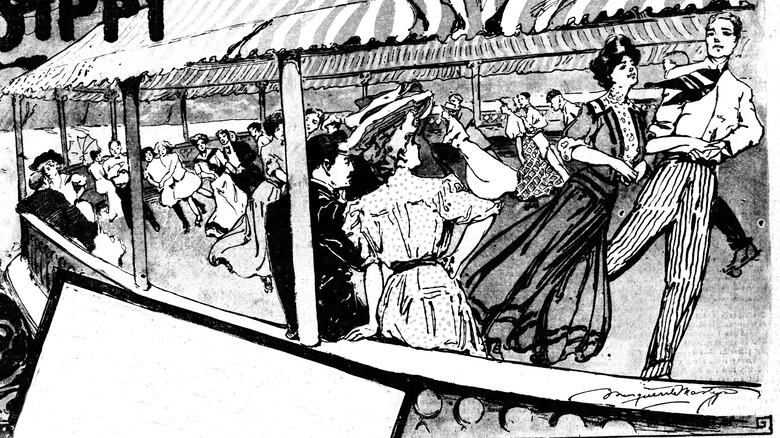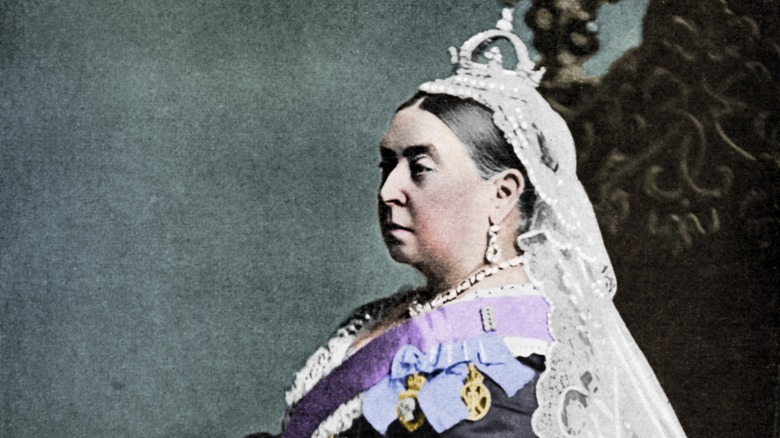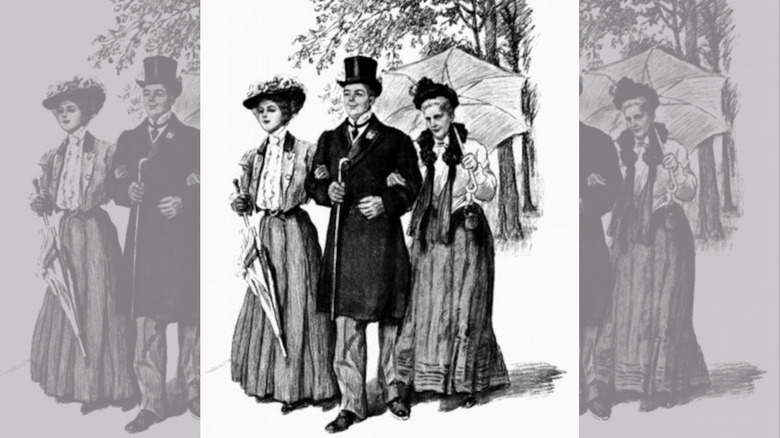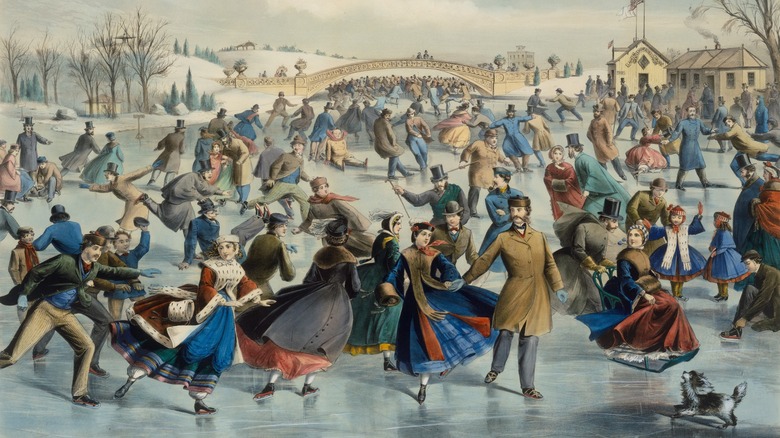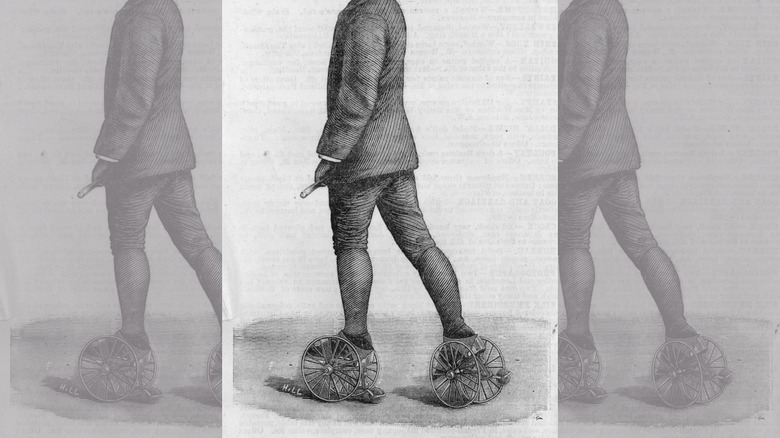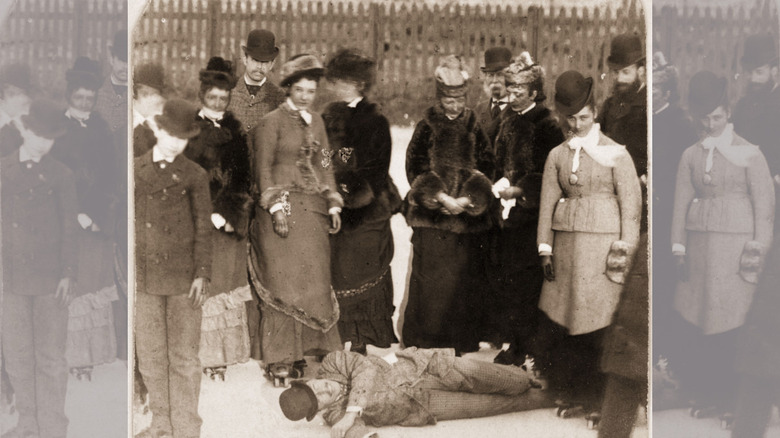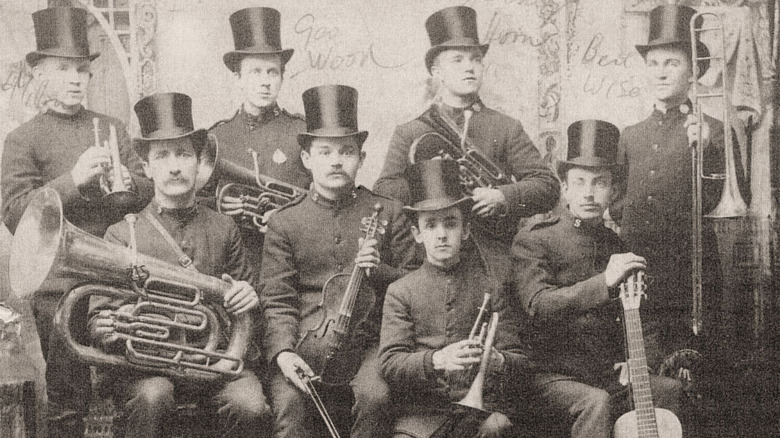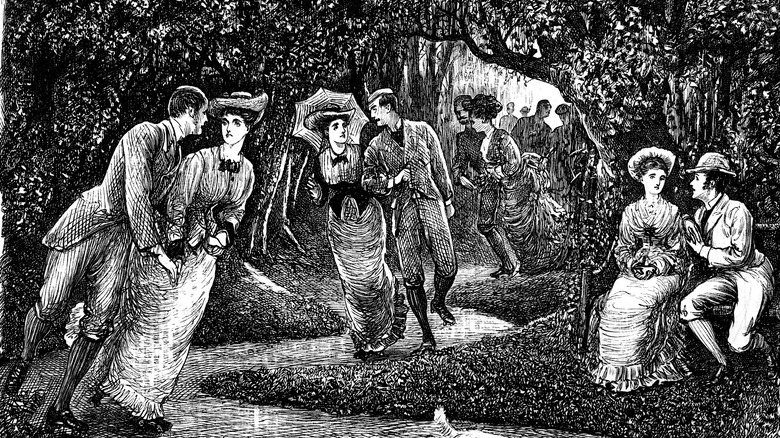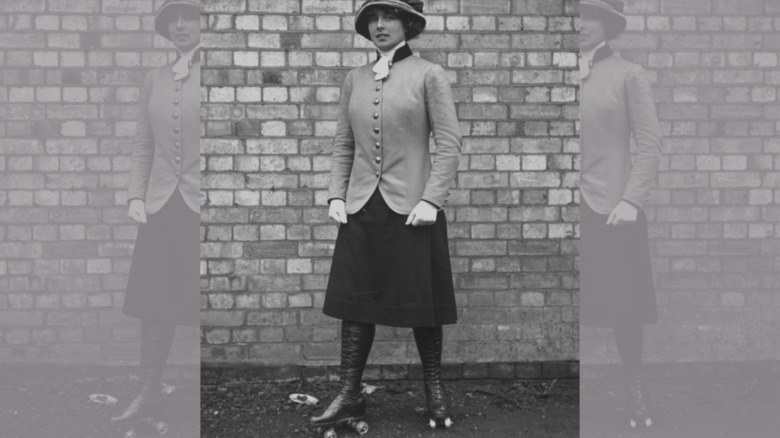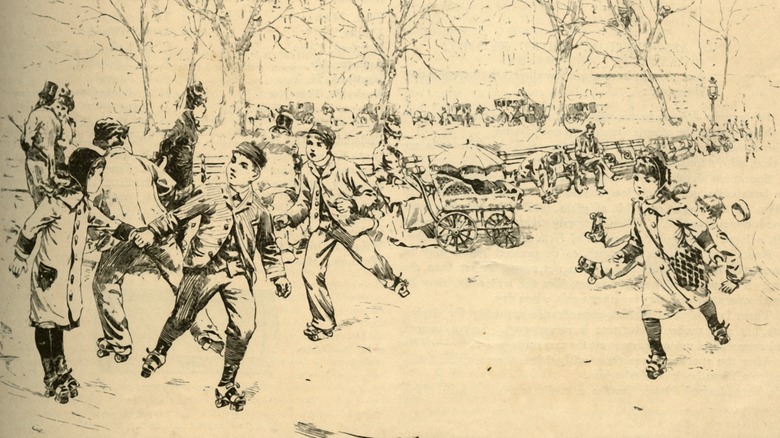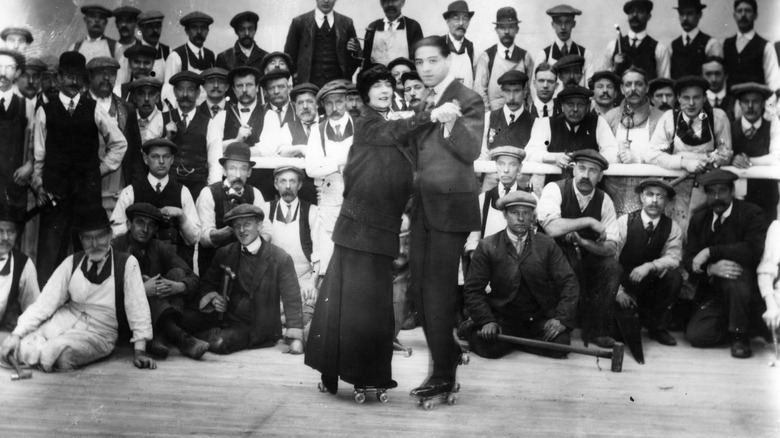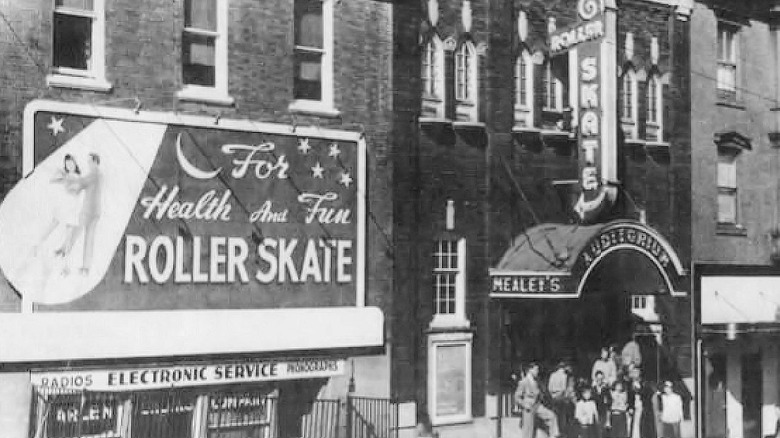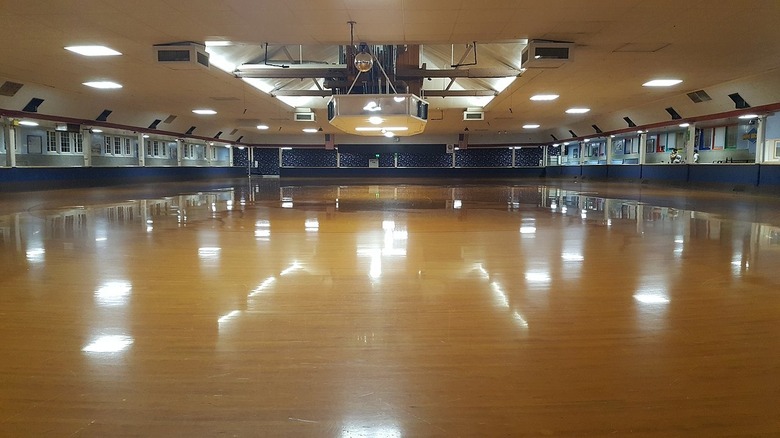How Rollerskating Sparked A Sexual Revolution
Rollerskating has been around for centuries. While its popularity and presence ebbs and wanes, it never really goes away. There are a lot of simple reasons for its durability. For one thing, it's fun — gliding about on a pair of skates is exhilarating (once you learn how to not fall on your butt all the time), and it's an activity you can engage in with all of your friends. Then there's the nostalgia factor: rollerskating has been around for so long every older generation has fond memories of rollerskating in their youth, and every new generation arrives just in time for rollerskating to have a fresh "old-school cool" moment.
But rollerskating has had a powerful impact on the social history of the world. It's been the center of fights against racism, it acted as an empowering subculture for people, and it continues to promote feminism and gender equality around the globe. Rollerskating is one of the few activities people can engage in that combines a sense of freedom with actual freedom — the ability to roll anywhere, almost effortlessly.
Often forgotten, however, is the role the activity has played in sexual politics. Rollerskating experienced its first bloom of popularity around the world shortly after a stable, four-wheeled design for the skates was introduced — right during one of the most strict and prudish eras of Western history, the Victorian Age. Here's how rollerskating sparked a sexual revolution.
Victorian attitudes towards sex were strict
If you've watched TV shows like "The Gilded Age," you know that the Victorian Era, named after the reign of Queen Victoria in England and encompassing the years 1837 to 1901, was a time of fussy morality and tightly-controlled social interactions. This was especially true of relations between the genders. As noted by Britannica, sex was a forbidden topic in polite society, and many people — especially women — were actively proud of knowing very little about sexual matters. And society was organized in a fairly strict hierarchy in which your gender played a huge part — women, by and large, could not vote, and in many cases, could not own or inherit property.
This restrictive attitude was reflected in the clothing that women had to wear in public. As noted by The Vintage News, women's fashion during the Victorian Era was voluminous, heavy, uncomfortable, and very prudish. No exposed skin was tolerated, and even showing any hint of undergarments was a bit of a scandal. While Victorian dresses could be quite beautiful and were often fashion-forward, they were also designed to promote the idea of women as chaste creatures. As noted by Refinery29, this didn't mean that women in the Victorian Era didn't enjoy, pursue, and think about sex — it was just that no one was supposed to talk about it openly.
Young couples always had chaperons
If there's one universal truth that ties all generations of humans together, it's that the kids are interested in the birds and the bees. In the Victorian Era, young people were just as eager to get together and get busy — and their elders knew it.
This is why, as reported by BBC News, almost all social events during the Victorian Era were watched carefully by a variety of chaperones. As MyLondon notes, just about any social occasion attended by a young couple was closely monitored by parents or other older authority figures. According to The Social History Society, even if you went over to your beau's house to sit and talk, an aunt or other relative would be there, keeping on eye on you. These chaperons watched carefully to ensure that the kids didn't do anything immoral or scandalous.
As you might imagine, this not only made dating and courtship a bit stiff and awkward for a lot of people, but it also made any sort of intimacy almost impossible. And as noted by How Stuff Works, there were plenty of rules covering just about every other aspect of courtship, making dating a maze of rules. This led to some crazy workarounds. National Geographic notes the existence of "escort cards," which used printed dirty jokes as a way for couples to get hot and bothered without prying eyes or ears noticing. No wonder young folks sought ways to circumvent the dating rules.
Victorians loved to ice skate — but it was dangerous
Before there was rollerskating, there was ice skating. According to Smithsonian Magazine, ice skating was a well-known activity in areas of Northern Europe (where there were plenty of frozen lakes and ponds to skate on), but in other areas of the world, it was the province of the wealthy elites who could afford to travel to places where skating was possible. For example, England had only about 18 days a year where ice skating might even be feasible, which meant the average citizen never had the opportunity.
Another problem with ice skating as a leisure activity lay in its danger. Londonist notes that there were numerous accidents and even deaths associated with ice skating. In January 1867, hundreds of skaters plunged into icy waters when the ice on Regent's Lake cracked — and many died despite frenzied rescue attempts. Even worse, the lake quickly froze over again, trapping many bodies beneath the ice.
Attempts were made to construct artificial ice rinks for skating, with mixed results. Early attempts tried to replicate ice with a mixture of materials that was unstable and bad-smelling. As a result, the advent of rollerskating found Victorian society more than ready for an alternative to the more dangerous and elitist ice skating.
A technological breakthrough sparked a fad
It took rollerskating a long time to become popular — about a hundred years, in fact. The New York Times reports that roller skates were invented in the 1760s by a man named Joseph Merlin. The problem with roller skates of the time was that they were extremely difficult to steer or control — once you got going, you just had to hope nothing got in your way. In fact, Merlin crashed into a mirror when he debuted his skates at a fancy masquerade party, setting the tone for the next hundred years of skating history.
According to BBC News, it wasn't until 1863 that someone came up with the solution. American inventor James Leonard Plimpton designed the first-ever four-wheeled skate. The design allowed people to actually turn while skating, while also affording them greater stability. While the original 19th-century skates might look crude, they're recognizable to modern skaters — and the activity became immediately popular. Plimpton himself opened up skating rinks, and it soon became fashionable among the wealthy members of society. By the 1870s, rollerskating had come to England, with 50 rinks opening up in London alone. The Social History Society notes that the press dubbed the craze "Rinking," and in his book "Victorian Material Culture," author Richard Menke notes the fad was also called "rinkomania." It dominated the press and popular culture of the time.
Roller skating was initially considered wholesome
Victorian Era mores and attitudes were pretty strict and prudish by modern standards. One reason rollerskating caught on like a house on fire at the time was its apparent wholesomeness. As noted by JSTOR Daily, while there was some initial concern about the frequency of injuries suffered by skaters and the possibility of "pathological" effects on young people's development, the medical world quickly pronounced rollerskating to be healthy exercise as long as it was pursued to exertion.
BBC News notes that the health benefits were part of rollerskating from the very beginning. When James Leonard Plimpton invented the four-wheeled rollerskate that made steering and stopping possible while skating, he opened his own skating rinks to promote the idea, and specifically heralded them as not just wholesome fun for families but as a health and fitness destination.
The end result was a leisure activity that had all the exercise benefits of ice skating with less risk of falling into freezing water that was also much more accessible to a wider swath of Victorian society. In his book "Victorian Material Culture," author Richard Menke reprints a British magazine article from 1875 that defends rollerskating as safe and notes that "everything that can be done with ... ice-skates" can be done with roller skates. There's a hint at the sexual revolution rollerskating would kickstart when the article notes that "A fine, graceful skater of a girl is more worth looking at than a man any day."
Skating rinks had a party atmosphere
One thing that's been true throughout the entirety of human history is that meeting potential romantic partners usually requires some social lubricants. These traditionally include libations, crowds, and music — in other words, a party. This remains true today, as going out to clubs and bars remains a key way for people to meet each other and lower their inhibitions enough to get to know each other.
So it was during the "rinkomania" craze of the Victorian Era. BBC News notes that rollerskating quickly attracted young folks, in part because the older generations didn't skate. Another reason rollerskating rinks became popular with the younger crowds was the party atmosphere most offered. According to The New York Times, most rinks hired brass bands to play while everyone skated, turning what could have been regarded as exercise into a "social event." The Social History Society reports that some bands literally played all day and into the night, and many rinks advertised their decor and amenities. And according to historian Gavin Holman, some rinks even hired local bands to play in the same way your local pub brings in musicians to entertain everyone on a Friday night.
By the mid-1870s, opulent rinks were opening that boasted beautiful designs, refreshments, and expansive skating areas. Combined with live music, they were giant parties where young folks could meet up — and even make chaste physical contact.
The rules were relaxed
As noted by BBC News, during the Victorian Era, there were more than a few simple rules for dating someone's daughter — there were a ton of rules. Described as a "stultifying atmosphere" (which really sounds conducive to romance), the assumption was that young men and women couldn't be trusted to be alone with each other prior to marriage, and so had to be constantly supervised by chaperons accompanying them on every date or social event.
Enter Rollerskating rinks. As noted by The Social History Society, no one doubted that rollerskating was wholesome — it was public, it promoted healthy exercise, and it wasn't exactly a rambunctious activity (no one was attempting triple axles out there). As a result, the uptight parents and stern aunts of the world didn't have any good excuses to forbid young couples from rollerskating.
But the rink was a haven for those lusty kids. The older relatives who chaperoned young courters were reluctant to risk their dignity on skates, giving young lovers a rare chance to converse in something approaching privacy without causing a scandal. To be sure, the chaperons still tagged along, but they tended to stay on the sidelines. That made the rinks "neutral ground on which the sexes may meet," according to a newspaper article of the day.
The clothing was also more casual
As explained by The Vintage News, ladies' clothing in the 19th century wasn't exactly causal and revealing. In fact, the fashion of the time trended hard towards the restrictive, the uncomfortable, and the prudish. If you look at photos of women in the Victorian Era, you can count on not seeing any skin below the neck.
Again, rollerskating came along to give the gals a little fashion breathing room. The Social History Society notes that the rules of attire got bent due to the athletic nature of the activity. Ladies were suddenly able to wear slightly shorter — and slightly tighter — skirts while skating (an innovation BBC News reports was imported from the United States, always the leader in eroding prudish rules), which gave a little extra oomph to their flirting. Best of all, as noted by MyLondon, they had a built-in excuse for changing clothes — the tighter, shorter clothing made it easier and safer to skate because they had more flexibility.
While these benefits might seem tame in the modern world, at the time, they sparked a mini-sexual revolution of sorts. Just put yourself in the position of a young person burning with desire for someone, and then they suddenly slip into a slightly less oppressive dress. The effect must have been pretty powerful.
It gave couples an excuse to touch
Rollerskating loosened a lot of the rules surrounding courtship during the late 1800s, giving young people a rare chance to hang out without a nosy chaperon. And it gave young women a chance to dress a little bit more daringly, since the restrictive fashions of the time impeded good skating form.
But rollerskating also introduced far more powerful freedom for people engaged in a courtship: The excuse to touch each other, normally quite forbidden. Touching is a key component of flirtation, as noted by The Science of People. Touching someone in a subtle, natural way establishes a connection and indicates interest while promoting intimacy — which is why people have been touching each other's arms when laughing at their jokes since time immemorial.
As Bust points out, rollerskating bent the old-timey rules about physical contact because the ladies (naturally not the manly men) might need a little assistance keeping their balance while rolling about, and even the sternest matron couldn't fault a young man for helping his date avoid a fall. And as Jezebel notes, racing around a rink while your chaperon squinted at you from far away made it a lot easier to be even bolder — holding hands or more. Unless your chaperon brought along binoculars, chances were you could get away with a lot more physical contact than otherwise possible.
The rollerskating rink was the Tinder of its time
Romance in the Victorian Era wasn't exactly easy. According to History of Yesterday, meeting and dating people was complicated by two main things: Inexperience and strict codes of public behavior. For the former, there were literally dating manuals that young people were expected to study and learn and specific social events—like the infamous "Coming Out" parties debuting young women who had attained marriageable age—that were tightly controlled. For the latter, there were chaperons at all times to ensure that no one could be accused of inappropriate behavior.
This is all well and good if your goal is to make sure everyone keeps it in their pants until marriage, and if you have the family or social connections to meet potential mates. If you lacked those things, meeting someone you might want to date, canoodle with, and possibly marry was challenging, because there was no Tinder or Match.com.
But, as MyLondon explains, there was the rollerskating rink. At a roller rink in the late 1800s, you could be assured of two things: There would be other young, single people, and there would be few — if any — chaperons. All the social rules were just slightly relaxed, in fact, giving you the chance to not just observe but to interact with other people in a more casual way than was normally tolerated.
Rollerskating started to get a reputation
When it was a relative novelty in the late 1800s, rollerskating rinks were popular places for the young and fashionable—the influencers of their day, in a sense. Their popularity was boosted when rollerskating rinks became the place to meet other young singles somewhat free of the restrictive rules of the time governing dating and courtship.
But the romantic aspect of rollerskating led directly to its downfall. Historian Ann Kourdas notes in her book "Female Adolescent Sexuality in the United States, 1850-1965" that as early as the 1880s church leaders, educators, and activists began to warn that rollerskating was "immoral" and dangerous to young women. According to The New York Times, by the early 20th century the rollerskating rink had acquired a reputation as a "pick-up joint" where it was dangerous for respectable young women to be seen. Not coincidentally, this coincided with new labor laws that gave the working class more leisure time, as noted by The Atlantic. Suddenly the general population had the time to roller skate, and its popularity briefly exploded—while its reputation declined, in part because of the snobby attitudes of the wealthy. In other words, rollerskating was still a great way to have fun and meet other people, but now it was viewed as a "low class" environment that attracted the wrong sorts.
The revolution didn't last long
The initial rollerskating fad and the mini-sexual revolution it sparked didn't last too long. As noted by Jezebel, by the end of the 19th century the popularity of rollerskating had faded, and many of the rinks that had been built to accommodate the hordes of horny young Victorians began to close. The rinks that did stay open began to suffer from age and deferred maintenance, according to The New York Times. Even when well-maintained the rinks had a dingy appearance after a while, in part because the wooden floors needed regular doses of sawdust, giving them the "unkempt" appearance associated with saloons.
As noted by The Atlantic, when improved labor conditions gave more leisure time to the less wealthy, rollerskating began to rise in popularity again, and experienced a full-on boom during the 1920s. That boom ended with The Great Depression, and since then the pastime has experienced many highs and lows, from the Roller Disco craze of the late 1970s and early 1980s, the inline skate revival of the 1990s, and as noted by Buzzfeed the joyous Tik Tok trends of recent years.
But those later fads for rollerskating weren't the boiling ocean of hormones that the initial experience was. For all practical purposes, the sexual revolution sparked in the late 1800s by rollerskating ended with the Victorian Age that made it necessary.
